#era: belle époque
Explore tagged Tumblr posts
Text

Women's Red and Black Day Dress, 1897.
#fashion plates#historical fashion#19th century#century: 1800s#clothing#women's fashion#nationality: french#dress#era: victorian#day dress#year: 1897#decade: 1890s#nationality: dutch#publication: de nouveaute#red#black#day wear#gown#era: late victorian#colour illustration#op's favourites#era: belle époque#era: french belle époque#era: third republic
58 notes
·
View notes
Text


Evening Dress
c. 1913-1915
Franklin Simon Co.
Canadian Museum of History
#1910s#belle epoque#belle époque#Edwardian#fashion history#Edwardian era#historical fashion#dress history#history of fashion#1910s fashion#frostedmagnolias
2K notes
·
View notes
Text
Etiquette of the Edwardian Era and La Belle Époque: Courting
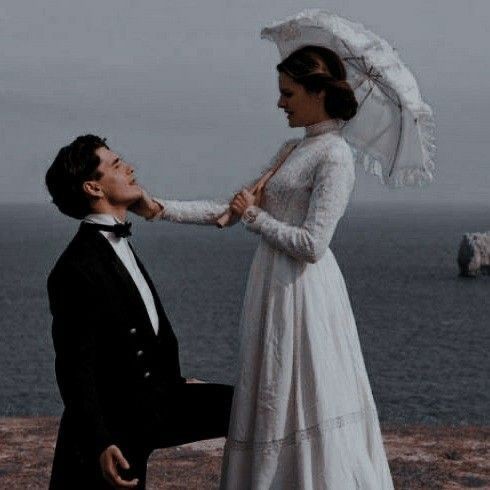
This is a new set of posts focusing on the period of time stretching from the late 19th century to the early 20th Century right up to the start of WWI. I'll be going through different aspects of life. This series can be linked to my Great House series as well as my Season post and Debutant post.
I get asked a lot about courting, what's acceptable or what's off limits and how one may woo a prospective spouse. So let's explore how to win the hand and heart.
Meeting (not so cute?)

Firstly, it is really difficult to have a meet cute in the Edwardian era. Women and men are kept separate for most of the day, only really getting to meet at designated events: A dinner, a ball, a social event. Meeting in the park is a cute idea but a gentleman can't just approach a lady (or another gentleman) without being introduced by a third party, either a senior party or a mutual friend. However, an introduction at a ball is sort of like Cinderella's get up, it ceases to matter when the ball is over. Your gentleman must not approach a lady after that ball, he must be reintroduced. Once an introduction has been made, he can speak with her.
An Interest

When an introduction has gone satisfactory, a gentleman must make the first move by calling to her parents'/guardian's home and making a formal request to begin courting. Her parents/guardians must consent, usually leading to a short brief interview of the gentleman's family, his connections, his wealth (though in not so vulgar terms, they may inquire where he lives which is an indicator). The woman's opinion did matter, she could give her reasons for accepting or turning down the offer. When the interest is approved, the gentleman can start offering invitations.
Three's Company
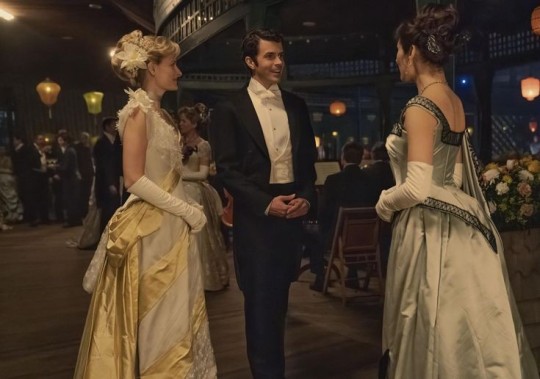
Of course, just because the parents agree, doesn't mean the couple gets to be alone. The young lady will be accompanied by a chaperone either a lady's maid, a governess, her mother or another female relative. While the couple is together, the chaperone will always be a few steps behind or have them in sight. She's there to ensure that nothing more than a conversation happens. This is not only for her young lady's reputation but also to save the man from any claims of impropriety. The chaperone also serves as a sort of spy, gauging whether this relationship is worth pursuing.
Activities & Tokens
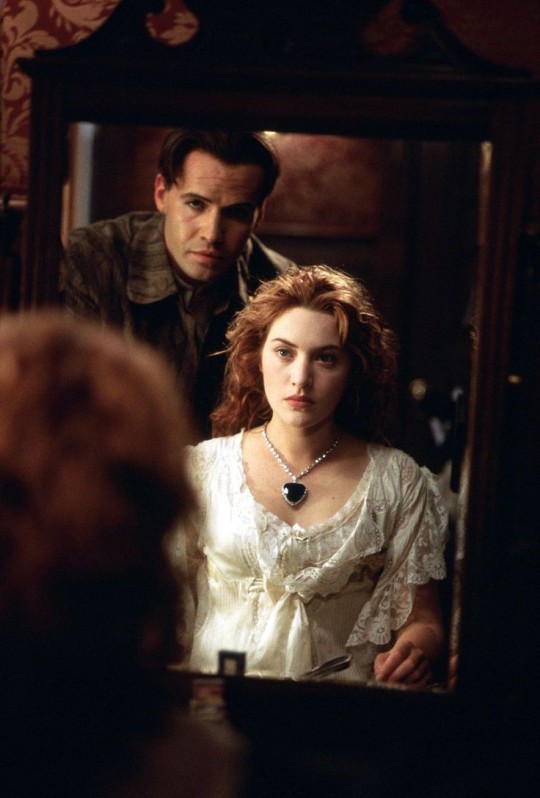
A gentleman may invite a lady out to lots of different activities. He can invite her for a promenade at a local park or gardens, out the theatre, visit her at home, invite her to galleries, to balls or to be his companion at sporting events such as the races, tennis matches or boat races. When visiting in the house, the gentleman would be expected to speak with all the family, be polite and courteous. This is how the family guages his suitably. The gentleman must provide transportation and funds for any excursion. Gifts are to be refined as well. Expensive gifts are considered vulgar and will likely be turned down. Small gifts such as flowers, books, cakes are acceptable. Gifts aren't as important as the time spent together.
Rules of Engagement

There are certain unspoken rules surrounding courtship that every gentlemen must follow for a successful courtship:
A gentleman should always pay attention to his lady, and not exclude her or cast her off for others
A gentleman never smokes in front of his lady nor forget to remove his hat.
A gentleman must always offer to refresh his lady on an excursion
A gentleman must defend his lady from any offense be it an insult or a scene unfit for her eyes or within an argument. Throwing in an apology for any offense can add a cherry on top.
However if she's the one giving offense, without any reason, the gentleman must seek to create peace, apologising on her behalf.
When walking, a lady will be placed in the inside of the pavement.
A gentleman should never spend above his means to impress his lady. Staying within his means is not only smart but a show of restraint and a glimpse of what life ought to be if they marry.
A gentleman should always offer his assistance when a lady is exiting a carriage or going up a flight of steps or carrying anything heavy.
If a man accompanies a woman to a ball, he's expected to dance with her on her first and last dances of the evening.
A gentleman must always make his intentions known and not string a lady along with no intention of marriage. He must never joke about his intentions or lead her on.
Marriage
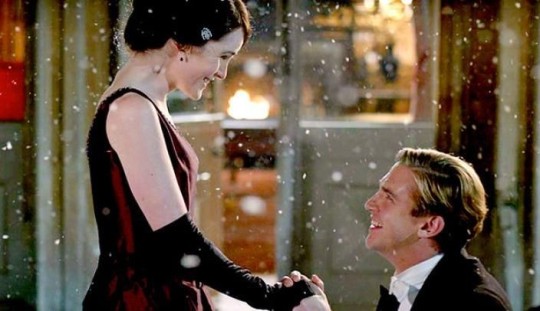
Courtship usually promises marriage which is why a gentleman or lady should not enter into courtship unless they would consider marriage. Courtship may last a few months or a few weeks and while it is going on, both sides should consider whether marriage would be a viable option of either of them. Parents/guardians would be consulted, the gentleman must make his intentions known to her father or nearest male relative before approaching the lady and popping the question. A courtship that doesn't end in marriage is seen as a failure and may damage the reputation of both parties, leading people to wonder what happened and who is to blame. For example is a perfectly eligible gentleman will not marry a perfectly eligible lady or she turns down his offer, people will usually leap to the conclusion that there is something lacking.
LGBTQIA+ Courting

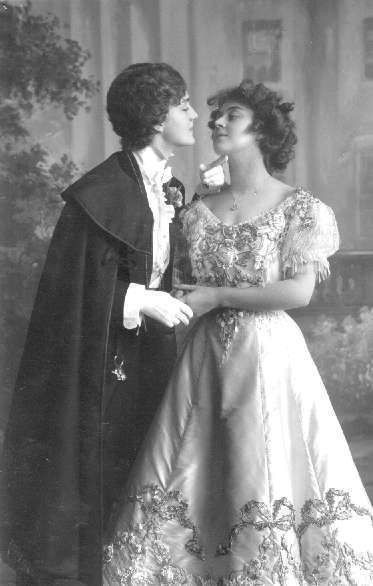
Gay people have always been here. They have courted and they have loved. Whilst it was illegal in this time in many parts of the world, love did prevail. (fun fact: lesbianism wasn't illegal because nobody wanted to explain what it was to Queen Victoria). The good thing to know is that courting whilst gay was likely easier in this period. Whilst there were restrictions and rules for straight couples and chaperones haunted their every step, none of this would happen if two people of the same gender stepped out together. Two gentleman going to the opera together or dining at a restaurant or attending a ball together (dancing in public was unlikely) or two ladies promenading in the park or attending a concert would not be examined like a courting couple. They would have more freedom to move around but of course, with legal impediments PDA was kept a minium. Whilst they wouldn't be allowed to marry legally, there was little stopping couples from moving in together. Nobody would say much about two spinsters sharing a home or two bachelors crashing together
#Etiquette of the Edwardian Era and La Belle Époque Courting#Courting#Courtship#The Edwardian Era#belle epoque#The gilded age#Edwardian#Etiquette#Fantasy Guide#Writing guide#Writing resources#Writing resource#Writer resource#Writer's resources#Writing reference#Writer reference#Writer's reference#writing#writeblr#writing resources#writing reference#writing advice#writer#spilled words#writers
1K notes
·
View notes
Text
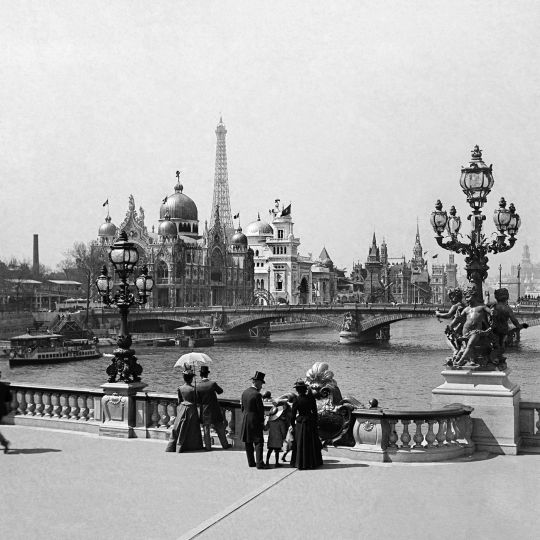
1900 Paris World's Fair.
Photo Léon & Lévy.
#belle epoque#belle époque#gilded age#victorian era#victorian#antique photography#antique#1900s#circa 1900#early 1900s#paris#history#black and white photography#black and white
462 notes
·
View notes
Text

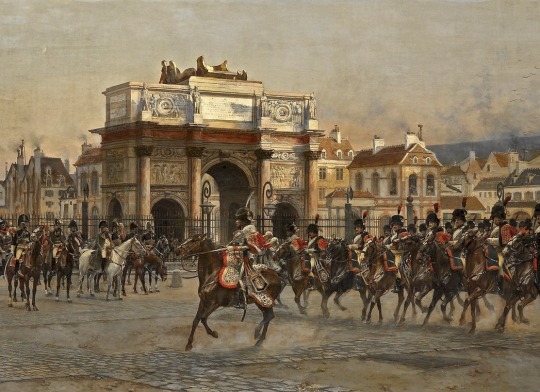

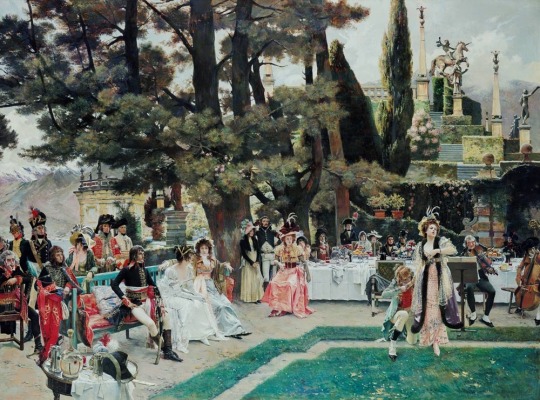
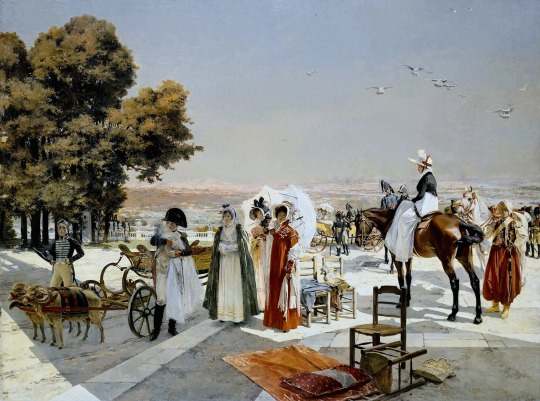
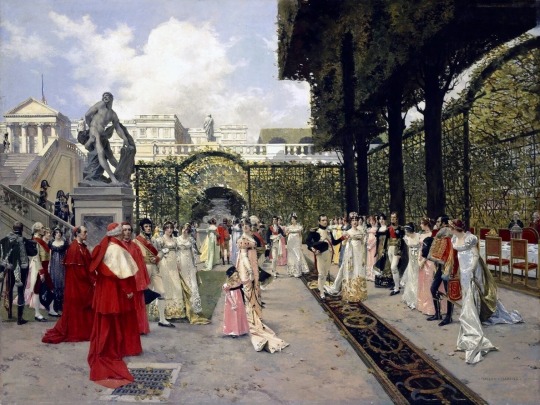

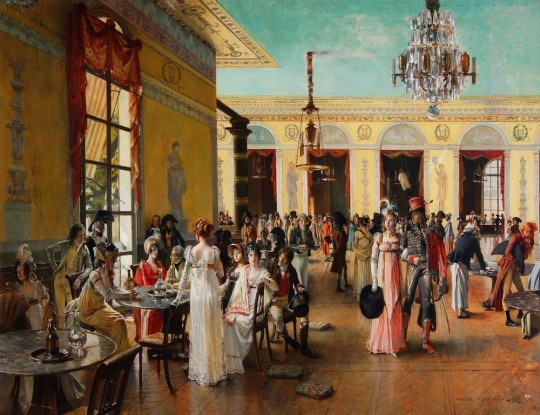
François Flameng: Scenes from Napoleon’s time
Spot Napoleon in all but one 🤓
#François Flameng#Flameng#belle époque#napoleonic era#napoleonic#first french empire#napoleon bonaparte#napoleon#french empire#France#art#French art#history#1800s#1800s art#19th century#Paris#malmaison#Arc de Triomphe du Carrousel#café Frascati#frascati#french revolution#frev#empire style#art history
241 notes
·
View notes
Note
out of curiosity i listened to steampianists ‘the botanist’ that you talked about in the tags of my last ask…it really is perfect for rollo. my god. i can imagine him going to great lengths to ensure his love blooms with his darling. if you ever write that fic ill print it out and tape it to my walls. rollo and the two? fics youve written live rent free in my brain and im composing a playlist for him now. i am. in deep.
-pot roast brain anon from a couple days ago
Pot roast anon, hello!!!!!! >w< omg I'm so happy you listened to the song and agree that it suits Rollo!!! The story is so eerily visceral. I love it so much. "The Detective" is the sequel to "The Botanist" and it involves the singer (the detective) trying to solve the murders committed by the botanist, but in the process he's interrupted by the scientist from "Black Hole" after she brings on the end of the world with her experiment! I adore Steam's work. Every song is so good. orz
I love these lyrics from "The Botanist":

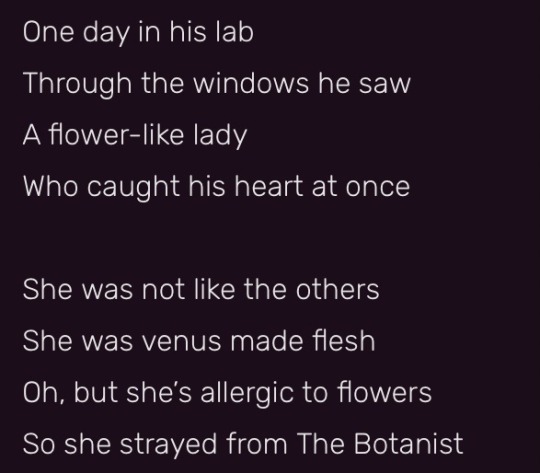

A lady who is allergic to flowers and a botanist who is allergic to humans,,, waaaa it's such a yummy concept!!! Rollo who is allergic to humans (magic) falling for a darling who is so in tune with their magic...... and the way the gloves go from green to red over the course of the song, indicating that something dire happened to the lady (it's revealed in "The Detective" that the botanist would remove the hearts of the women he kidnapped). The symbolism in making someone or something bloom. Rollo whose talent is literally gardening. Rollo who cared for and grew the Crimson Lotus........ I LOVE HIM SO MUCH. OTL he really does feel like the botanist character in the song.
ALSO!!!! The way the lyrics transition from "passionate for flowers" to "passionate for a flower." Going from plural to singular as this flower (the lady) fills the botanist's heart with some sort of crooked adoration. A darling couldn't fix Rollo. In fact, you would just make him worse (more obsessed) unintentionally. >_< I really want to write a fic inspired by this song for Rollo!!! It suits him so well. I'm happy you would want to read a fic like that!! <3
I've only written three fics for Rollo so far (The Diary of Rollo Flamme, Eden, and Crow & Goat in Courtship), but it's not nearly enough. He was so crazy during his confrontation with Malleus, Idia, and Azul in Glomas. The way he actively tried to strike Malleus down????? AAAAAAA. Unfortunately, Rollo will indeed strike him down in the dead dove fic I have planned. ;;;; he's scary,,,,
I think "The Botanist" could also suit Jade if I'm writing him as the clinically detached type (like in Monops's Reflection), but I need to get the eels out of my brain. T^T
#twisted chit chat#forgive me for rambling excessively orz#i really love steampianist's music :D the song 'tiny fiends' also reminds me of rollo to an extent#if i wrote 'the botanist' fic for rollo i would like to write it in the belle époque era#mainly because the fashion of that era is beautiful and feels very flower-like to me (perfect for a certain botanist (rollo) to notice you)
41 notes
·
View notes
Text

Style test. March 1883, featuring a deep cut Ayreon reference.
When you’re at a party in the city most associated with your childhood misery but the drip is on point. 🔥
#ayreon#transitus#*spends 45 minutes explaining how it’s 100% historically plausible for Daniel to be wearing Frans B Cocq cosplay#art#tommy karevik#arjen lucassen#rembrandt#the gilded age#victorian era#belle époque#fanart#digital art#illustration#sepia
11 notes
·
View notes
Text
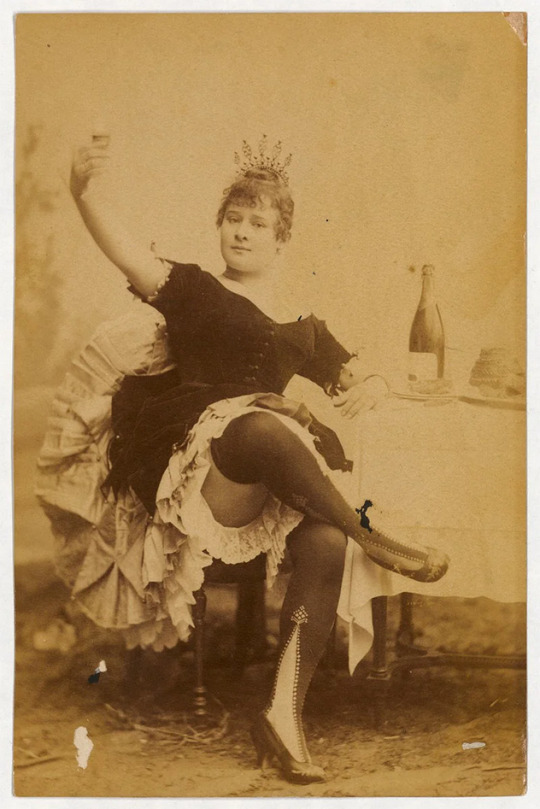
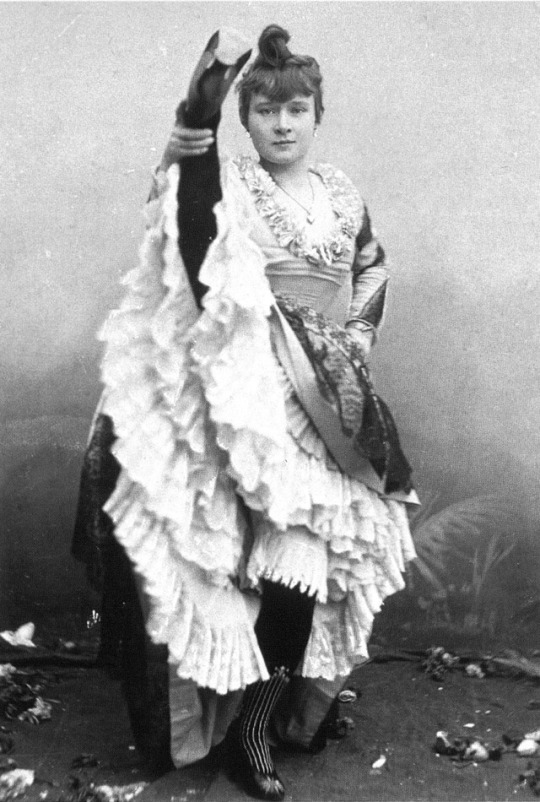
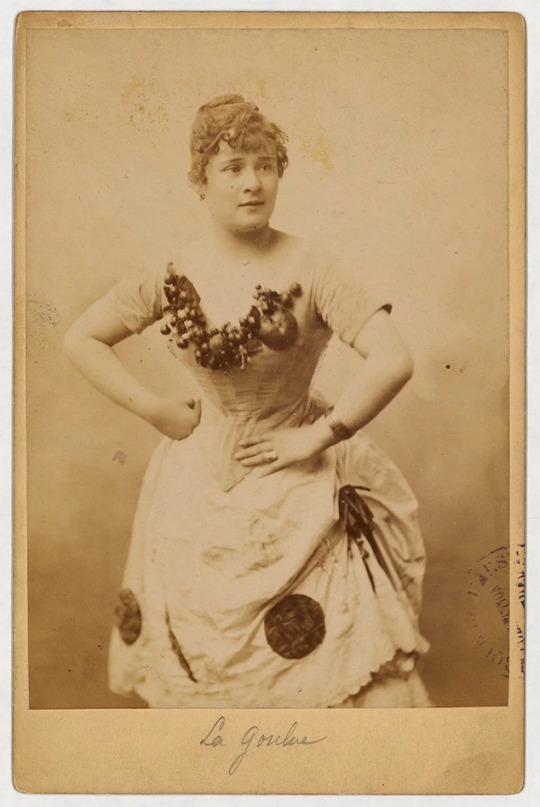
La Goulue (Photos: 1885-90)
Louise Weber, born on July 12, 1866, was a pivotal figure in the realm of can-can. The dance style gained immense popularity, particularly in Paris during the late 19th century. Louise, better known as La Goulue, quickly became an iconic figure of her time.
La Goulue (The Glutton) earned her stagename when she "dried the bottoms of glasses in cabarets." This audacious behavior became synonymous with her fame, contributing to her larger-than-life persona. Her vibrant personality shone both on and off the stage, captivating audiences with her performances filled with enthusiasm and charme.
Legend has it that during a wild performance, La Goulue caught sight of the Prince of Wales nestled between two wheels, as he had come incognito to enjoy the evening at the Moulin Rouge. She allegedly called out: "Are you paying for the champagne? Is it you who invites or is it your mother who treats?"
Her style of fashion was characterized by flamboyant outfits, featuring voluminous petticoats, feathery embellishments, and captivating corsets. She had perfected her leg kicks to such an extent that she could score with calculated glimpses: The insatiable dancer had embroidered a small red heart into the crotch of her slip, which became a sensation and a coveted reward for the gentlemen of her choice.
One can only imagine the scandals, buzz and gossip that surrounded her during the Belle Époque in Paris.
#La Goulue#Louise Weber#19th century#Can Can#Moulin Rouge#Belle Époque#photography#early photography#1880s#1890s#victorian#victorian era#Miss Cromwell
3 notes
·
View notes
Text
Home in my previous incarnation

#palais garnier#paris opera house#the phantom of the opera#christine daae#erik the phantom#erik destler#reincarnation#old soul#la belle époque#1800s#victorian era#19th century#lonely girl#eternal recurrence#esoteric#orphic mysteries#pythagorean theorem#contrapasso#soulmates#past life#my past#secret life#who i am
1 note
·
View note
Text

Félix Vallotton, “At the Beach” (Sur la Plage)
Swiss, 1899
#félix vallotton#post impressionism#les nabis#swiss artists#franco-Swiss artists#Victorian era#belle époque#turn of the century art#victorian painting#victorian art
3 notes
·
View notes
Text
Basically who I am inside: a timid pale and fragile Victorian girl
Two-part evening dress, Maison Clergeat, Paris, 1898-1900



Silk satin called “Charmeuse”, wool and sequin embroidery, lace flounce, muslin, taffeta lining. Gift of Madame Solange Granet, in memory of her cousin, Madame Montaudon, née Le Grain-Eiffel.
#la belle époque#la belle et la bête#la belle personne#le fantome de l'opera#palais garnier#victorian era#19th century#1800s#fashion history#late victorian#victorian fashion#historical fashion#late 1800s#1800s fashion#1860s#victorian aesthetic#victorian gothic#baroque#pachelbel#george frideric handel#henry purcell#johan sebastian bach#sherlock holmes#sherlock fandom#baker street#tale of two cities#paris opera house#christine daae#erik destler#wedding dress
355 notes
·
View notes
Text

Women's Purple Day Dress, 1880.
#historical fashion#women's fashion#fashion plates#year: 1880#decade: 1880s#century: 1800s#19th century#nationality: french#publication: la france élégante#era: victorian#era: belle époque#era: third republic#natural form#purple#violet#pinstripes#walking suit#walking dress#clothing#dress#day wear#day dress#era: french belle époque#colour illustration
58 notes
·
View notes
Text


Evening Dress
c. 1912-1914
Canadian Museum of History
#1910s#belle epoque#Edwardian#belle époque#edwardian era#edwardian fashion#fashion history#dress history#historical fashion#vintage fashion#frostedmagnolias
983 notes
·
View notes
Text
Etiquette of the Edwardian Era and La Belle Époque: A Day in the Life of a Socialite
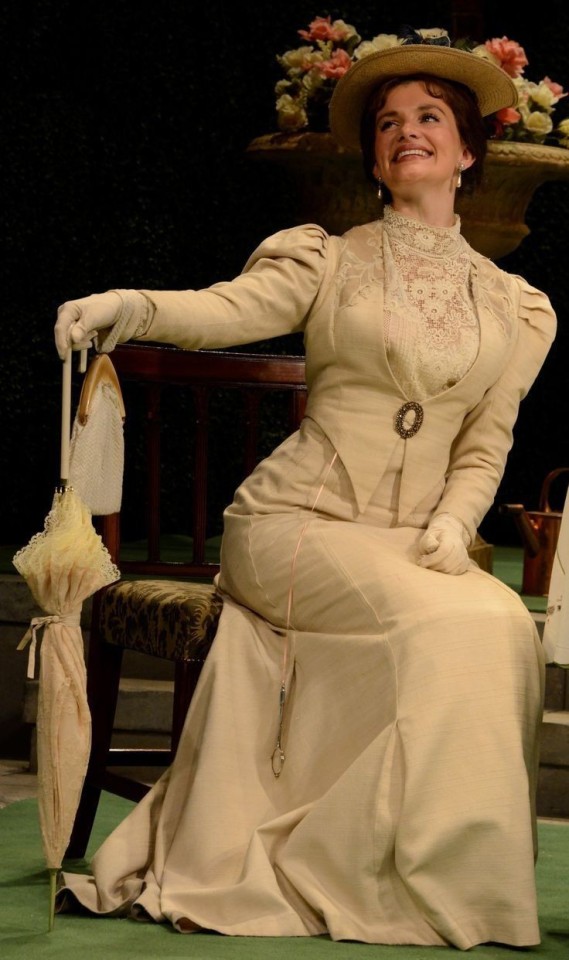
This is a new set of posts focusing on the period of time stretching from the late 19th century to the early 20th Century right up to the start of WWI. I'll be going through different aspects of life. This series can be linked to my Great House series as well as my Season post and Debutant post.
The socialite depending on her rank and country of origin, is the heart of the social world within this time period. It is she who hosts grand balls, attends them, hosts dinners where couples fall in love. But what does she get up to on a regular day?
Morning

The morning of the socialite usually began early - if she hadn't attended or hosted a ball the night before. Around 9, the Socialite would be awoken by the arrival of her hot water by her lady's maid. If she was married, she would have the luxury of staying in bed to eat breakfast. After she has eaten, she would ring for her lady's maid to help her dress. If she is not married, she would dress first and head downstairs and have breakfast with her unmarried sisters, her brothers and father. After breakfast, the married socialite would withdraw to her business of the day, such as meeting with the chef to discuss menus for the following days. She might look over paperwork and letters concerning the house, her social circle and for charities she supports. The unmarried Socialite might just jump straight into her charity work.
Midday - Afternoon


Luncheon would be served around 1. After luncheon, the ladies of the house may travel to appointments such as fittings or paying calls to friends. Paying calls means dropping in, leaving one's card at the door and being admitted for a chat or some tea. Unmarried socialites might be attended by a lady's maid. Socialites may attend charity meetings, board meetings at this time. Tea would be served around four. After the tea is finished, the children would be brought down to spend time with their mother. This might be the only time a Socialite mother saw her children.
Evening

On a quiet evening at home, around 8, the butler would signal the start of supper giving the family and any staying guests, 15mins or more to get ready. Lady's maids would already be upstairs at this point, helping their mistress with dressing. When the Socialite head downstairs, linger in the drawing room to chat with the family snf any guests they might have. She would withdraw to the drawing room for coffee and tea with the other ladies while the men stay in the dining room to drink and smoke. When the men have finished, they join the ladies before going up to bed for cards and such.
On evenings, she would be a guest, she would repeat most of the steps above but instead, travel to dinner in her carriage. She would arrive, be announced and then escorted to the salon to greet her hostess and her fellow guests. If unaccompanied, she would be accompanied to dinner by an eligible male guest who is know to her. She wouldn't stay over if she's unmarried but head home afterwards.
On evenings that she's hosting an event (must married), she would repeat all the steps from a quiet night at home but everything would be larger, grander. She would be downstairs early to see to the details, waisting in the drawing room to greet her guests.
Hobbies
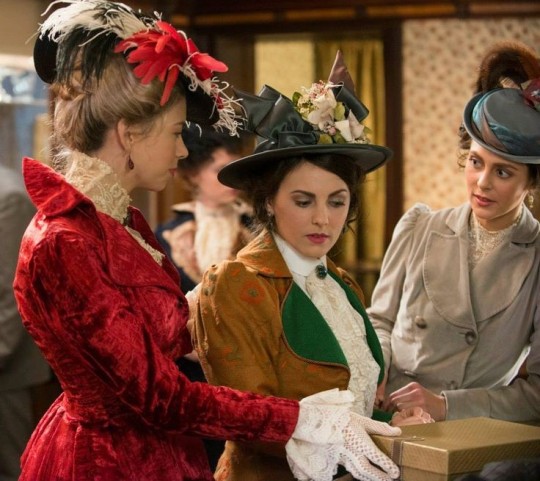
Socialites don't work so they will usually spend their day keeping busy. Married Socialites of course have a household and family to run. But all Socialites had an array of hobbies to keep herself occupied. As mentioned before, a socialite would patron charities. These usually involved little to no actual labour, it was more about raising awareness, raising money and occasionally visiting - often censored - the places they were supporting. The socialite would often spend the day shopping, this was the era of the rise of the department store. She would also attend a dressmaker's for fittings and consultations. She might enjoy physical pursuits like tennis, horseback riding or taking the air, all of these will of course be moderate hobbies. Watercolours, music and embroidery were popular hobbies of the time.
#Etiquette of the Edwardian Era and La Belle Époque#A Day in the Life of a Socialite#The gilded age#The belle epoque#The Edwardian Era#Edwardians#writing#writing resources#writeblr#writing reference#writer's problems#writer#writing reference writing resources
248 notes
·
View notes
Text

Geneviève Vix as Circe, photographed by Léopold Reutlinger c. 1907.
Source : @die-rosastrasse / @gretagarbos
295 notes
·
View notes
Text
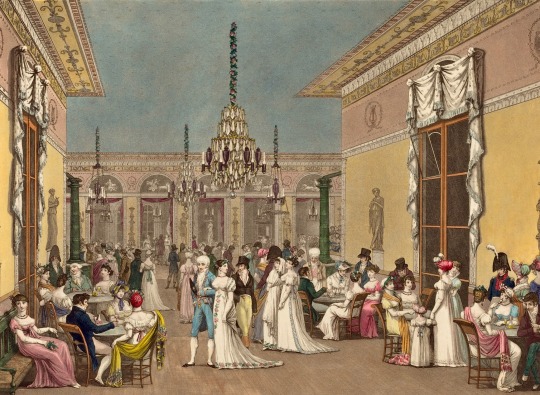
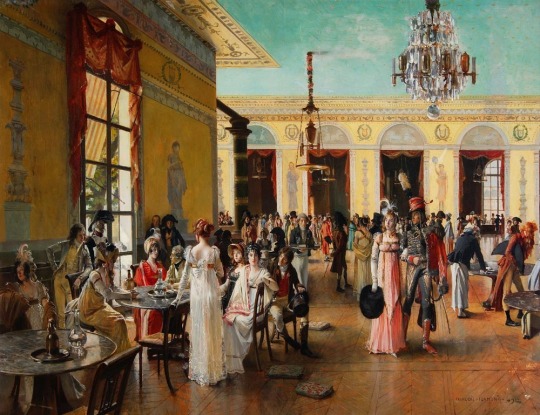
Top: Café Frascati in Paris, 1807, by Philibert-Louis Debucourt
Bottom: Café Frascati (A Scene From Napoleon's Time), 1893, by François Flameng
During the Premier Empire, the Frascati establishment, named after a famous Neapolitan ice-cream maker, was one of the most popular venues in Paris. First of all, it had a delightful garden, decorated with the busts of the greatest French and English poets, and lit up at night. A tunnel of wisteria and maiden vine, known as “l’ermitage” (the retreat), lent a charming atmosphere to the scene. The house was used as a café and salon de pâtisserie. On the ground floor it offered refreshments and some of the best ice-cream in Paris, with ballrooms. On the first floor were gaming rooms. Paris’s smartest set flocked here to spend the pleasant summer evenings.
The Maison Frascati closed at the Restoration, following the law closing down gaming rooms. (Source)
#Café Frascati#Philibert-Louis Debucourt#Debucourt#François Flameng#Flameng#napoleon#napoleonic era#napoleonic#first french empire#napoleon bonaparte#French empire#19th century#1800s#france#history#art#belle époque#French art#19th century art#empire style#empire#prints#paintings#painting
83 notes
·
View notes